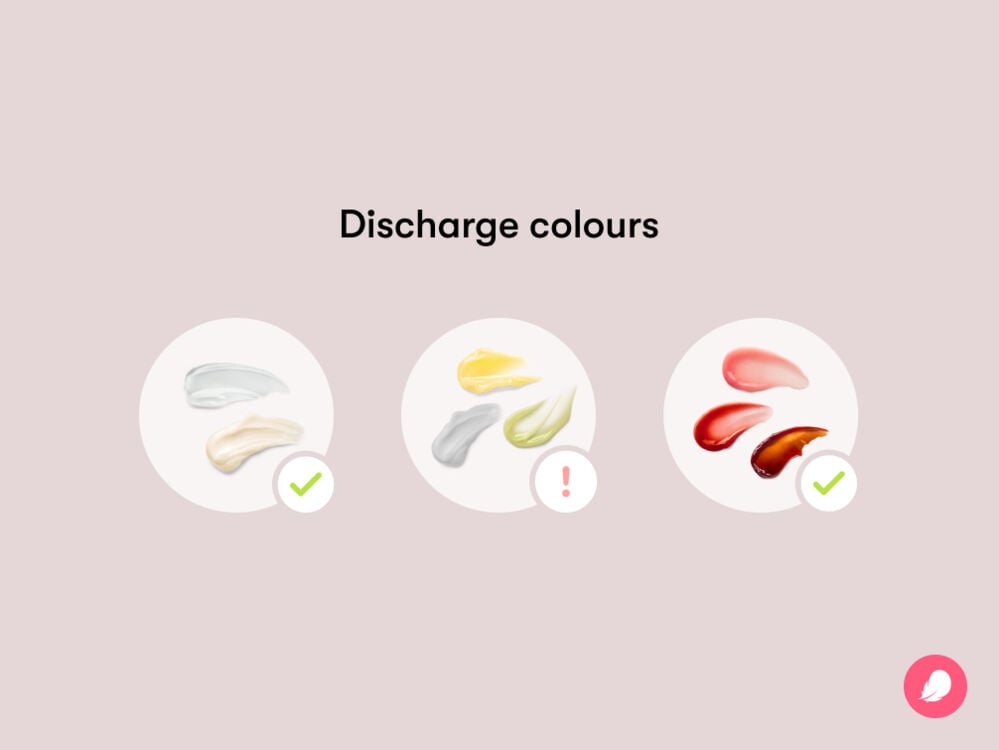Red, brown, white, or clear — discharge can look different at different points in your cycle, but why might yours look orange to you? Here’s the lowdown from an expert.
-
Tracking cycle
-
Getting pregnant
-
Pregnancy
-
Help Center
-
Flo for Partners
-
Anonymous Mode
-
Flo app reviews
-
Flo Premium New
-
Secret Chats New
-
Symptom Checker New
-
Your cycle
-
Health 360°
-
Getting pregnant
-
Pregnancy
-
Being a mom
-
LGBTQ+
-
Quizzes
-
Ovulation calculator
-
hCG calculator
-
Pregnancy test calculator
-
Menstrual cycle calculator
-
Period calculator
-
Implantation calculator
-
Pregnancy weeks to months calculator
-
Pregnancy due date calculator
-
IVF and FET due date calculator
-
Due date calculator by ultrasound
-
Medical Affairs
-
Science & Research
-
Pass It On Project New
-
Privacy Portal
-
Press Center
-
Flo Accuracy
-
Careers
-
Contact Us
Orange discharge: Everything you need to know


Every piece of content at Flo Health adheres to the highest editorial standards for language, style, and medical accuracy. To learn what we do to deliver the best health and lifestyle insights to you, check out our content review principles.
Vaginal discharge: From the white and creamy to the clear and stretchy — all of us will experience it, and it doesn’t always look the same. Advertisements for “feminine hygiene products” might have made you feel weary of yours, but discharge is totally normal and has some important jobs. It helps keep your vagina clean, healthy, and lubricated, while also fighting off infections and bacteria. Changes in your discharge can also be a sign that something might be going on inside your body. In other words, it’s fascinating stuff.
But have you ever noticed your discharge looks … orange? What’s with that? And where does it sit on the spectrum of normal vs abnormal discharge? Let’s talk about it with the help of an obstetrician and gynecologist at Cedars-Sinai Medical Group, California, US, Dr. Sara Twogood.
Key takeaways
- Generally speaking, orange isn’t recognized as being a common color for discharge.
- Healthy vaginal discharge is normally whitish or clear, mild smelling, and shouldn’t be accompanied by any uncomfortable vaginal symptoms like pain, itching, or irritation.
- If you’re nearing or have just finished your period, a spot of period blood might mix with your discharge — and it could cause it to appear pink, brown, or even red. Yours might even look orange to you.
- If your discharge looks yellow or green, it could be signaling an infection, particularly if it smells bad or is accompanied by soreness, itching, or swelling.
If your vaginal discharge ever feels abnormal for you or you think you could have an infection, make an appointment with a healthcare professional.
Is orange discharge normal?
So, first things first, discharge that’s actually orange isn’t really a thing. “But when a bit of blood mixes with normal discharge, it can take on a light brown color that people might interpret as orange,” explains Dr. Twogood. It might also appear pink or reddish.
“If you’re noticing it right before or after your period, this can be considered normal,” she continues. “If it’s right after ovulation – when some people experience spotting – that could also likely be normal.” But if it’s not around these times or it’s not something that usually happens to you during your cycle, it’s worth having a chat with your doctor.
Take a quiz
Find out what you can do with our Health Assistant
And what if you notice orange-looking discharge, but you don’t know if your period is due — or whether you might be ovulating? This is where Flo can help. Using a cycle-tracking app like Flo means you’ll always have a general idea about when your next period might be on the way. You can also use the app to track unusual changes in your discharge, helping you better understand your body’s patterns.
What happens when blood mixes with your discharge
As we’ve already mentioned, one of the main reasons why your discharge might appear rust-colored, red, or pink is if a little bit of blood gets mixed in with it. Your discharge might appear orange to you in this case but try not to worry. It’s generally nothing to be concerned about.
Your period
Your discharge can look slightly different just before your period and just as it ends. This is because your blood flow intensity changes. Typically, periods last between two to seven days, and you might notice that your flow is heaviest during the first three.
Just as your period starts and your flow is lightest, you might notice that it appears more like pink discharge rather than red blood. This is your period blood mixing with your discharge. Similarly, as your period comes to an end, it might appear brown. This happens because the flow from your uterus becomes slower, giving the blood more time to oxidize and mix with your discharge.
Ovulation
Ovulation marks the point in your cycle when one of your ovaries releases an egg. Many people won’t know when this has happened. However, according to a study, it’s estimated that around 5% of people with periods experience bleeding around ovulation. This will likely appear as very light spotting or bleeding, and it may mix with your discharge, causing it to turn pink. It may appear to you to be more of an orange color.
This isn’t the same as your period, but it does happen because of hormonal changes. During ovulation, your hormone called estrogen drops. This can cause the lining of the uterus to bleed. And there you have it: ovulation bleeding.
As we’ve mentioned, ovulation bleeding is quite rare, so if you don’t notice bleeding at this point in your cycle, then it doesn’t mean you haven’t ovulated.

Implantation
In early pregnancy, when a fertilized egg attaches to the walls of your uterus (implantation), a small amount of bleeding can happen. As with period blood, implantation blood can mix with vaginal discharge and could give it an orangey-looking tint. It’s worth noting that not everyone will experience implantation spotting.
What else can change the color of your discharge?
There’s more than one reason why you might notice a change in the color of your discharge. “Various vaginal and cervical infections can involve irritation that might cause a little bit of spotting or bleeding,” Dr. Twogood adds.
Bacterial vaginosis (BV)
Bacterial vaginosis is an infection caused by an imbalance of bacteria in your vagina. It’s usually associated with an abnormal gray discharge. BV discharge almost always comes with a strong, fishy vaginal odor — so that’s the thing to look out for.
Sexually transmitted infections (STIs)
A change in the way your discharge looks, feels, or smells could be a sign that you have an STI. For example:
- Trichomoniasis (also known as “trich”) is a sexually transmitted infection caused by a parasite. It’s often associated with a yellow or greenish vaginal discharge. Trich discharge might also be frothy, unpleasant-smelling, and accompanied by genital discomfort and pain when urinating.
- Chlamydia often has no symptoms, making it particularly difficult to spot, but some people may notice a change in the color of their discharge. It may appear yellow or gray.
- Gonorrhea is another STI that can have very few symptoms. Almost half of women won’t experience any at all. However, some people do notice a thick green or yellow discharge.
The bottom line is, if you’re noticing a change in your vaginal discharge that isn’t typical for you, especially if it’s accompanied by any other uncomfortable symptoms, make an appointment with your doctor. STIs and other infections can usually be cleared up with medication. But the sooner you get it, the better.
What does normal vaginal discharge look like?
Healthy discharge is typically clear or whitish, mild smelling, and can range from feeling wet and slippery to sticky and gooey or thick and creamy to drier and more pasty. It’s normal to notice around .5 to 1 tsp or 2.5 to 5 ml of it in your underwear every day.
“But ultimately, ‘normal’ discharge really varies,” says Dr. Twogood, “and lots of different factors will determine what it looks like for any one person. That’s why it’s important to understand your baseline and instead keep an eye out for red flags or changes that feel abnormal.”
Your discharge will almost certainly change as your hormones shift throughout your menstrual cycle. Some textbook discharge types you might notice throughout your cycle include:
- A white, creamy discharge earlier in your menstrual cycle, after your period
- A clear and slippery discharge resembling raw egg whites right before ovulation
- A drier discharge after ovulation

Other types of discharge to know about
- Clumpy white discharge: White discharge can be a standard healthy discharge, just a sign of your body doing its thing. It might be creamy and sticky or drier and more paste-like. But if it’s clumpy like cottage cheese and/or accompanied by itching and irritation, it could be a yeast infection.
- Pink or brown: Pink discharge and brown discharge can also happen when a bit of blood (e.g., from your period) mixes with your discharge. But if it’s happening in between periods or is accompanied by any uncomfortable vaginal symptoms, have a chat with your doctor.
- Yellow or green: Light yellow discharge can be normal, but if it’s also a clumpy consistency (like cottage cheese), it could be a yeast infection. If you have a darker yellow discharge or yellow-green or straight-up green discharge, it could be a sign that you have an infection, especially if there’s also a change in the consistency and smell of the discharge.
- Gray: As we said, gray discharge is often associated with bacterial vaginosis. It might be thin and watery and will almost always have a strong fishy smell.
What to do about orange discharge
As Dr. Twogood said, always keep an eye out for any types of vaginal discharge that aren’t normal for you. “If it’s around your period and it seems to be your pattern, it’s likely nothing to worry about,” she reiterates. “But if it feels unusual or you have any other symptoms that are worrisome — like pain, irritation, inflammation — then you can seek evaluation from a healthcare professional.”
More frequently asked questions about orange discharge
What does rust-colored discharge mean?
A browny-orangey discharge could be due to a bit of period blood mixing with your discharge. This is nothing to worry about. But if you’re not near your period — and especially if the discharge has a bad smell or you’re noticing other uncomfortable vaginal symptoms — it could be signaling an infection. So consult your doctor.
Can implantation cause orange discharge?
When a fertilized egg attaches to the walls of your uterus in early pregnancy, a small amount of bleeding can occur. That blood can mix with discharge and change its color.
What colors are unhealthy for discharge?
Yellow, green, and gray are colors often associated with abnormal discharge and may be signaling an infection. But orange, brown, and red discharge can hint at a problem in some cases, too — especially if you’re not near your period.


Hey, I'm Anique
I started using Flo app to track my period and ovulation because we wanted to have a baby.


The Flo app helped me learn about my body and spot ovulation signs during our conception journey.


I vividly
remember the day
that we switched
Flo into
Pregnancy Mode — it was
such a special
moment.
Real stories, real results
Learn how the Flo app became an amazing cheerleader for us on our conception journey.
References
“Abnormal Uterine Bleeding.” The American College of Obstetricians and Gynecologists, Dec. 2021, www.acog.org/womens-health/faqs/abnormal-uterine-bleeding.
“Bacterial Vaginosis.” Cleveland Clinic, my.clevelandclinic.org/health/diseases/3963-bacterial-vaginosis. Accessed 16 Oct. 2024.
“Bacterial Vaginosis.” Mayo Clinic, 10 June 2023, www.mayoclinic.org/diseases-conditions/bacterial-vaginosis/symptoms-causes/syc-20352279.
“Brown Discharge: 4 Causes and What It Means.” Cleveland Clinic, 25 July 2022, health.clevelandclinic.org/brown-vaginal-discharge.
“Cervical Mucus.” Cleveland Clinic, my.clevelandclinic.org/health/body/21957-cervical-mucus. Accessed 16 Oct. 2024.
“Chlamydia.” Cleveland Clinic, my.clevelandclinic.org/health/diseases/4023-chlamydia. Accessed 16 Oct. 2024.
“Gonorrhoea.” NHS, www.nhs.uk/conditions/gonorrhoea/. Accessed 16 Oct. 2024.
“Heavy and Abnormal Periods.” The American College of Obstetricians and Gynecologists, Oct. 2020, www.acog.org/womens-health/faqs/heavy-and-abnormal-periods.
“Implantation Bleeding.” Cleveland Clinic, my.clevelandclinic.org/health/symptoms/24536-implantation-bleeding. Accessed 16 Oct. 2024.
Kesavan, Shubhangi. “Vaginal Itching or Vaginal Discharge.” MSD Manual Consumer Version, June 2024, www.msdmanuals.com/home/women-s-health-issues/symptoms-of-gynecologic-disorders/vaginal-itching-or-vaginal-discharge.
“Ovulation.” Cleveland Clinic, my.clevelandclinic.org/health/articles/23439-ovulation. Accessed 16 Oct. 2024.
“Thrush in Men and Women.” NHS, www.nhs.uk/conditions/thrush-in-men-and-women/. Accessed 16 Oct. 2024.
“Trichomoniasis.” NHS, www.nhs.uk/conditions/trichomoniasis/. Accessed 16 Oct. 2024.
“Vaginal Discharge Color: What’s Normal and What Isn’t.” Cleveland Clinic, 29 July 2022, health.clevelandclinic.org/vaginal-discharge-mean.
“Yeast Infection (Vaginal).” Mayo Clinic, 11 Jan. 2023, www.mayoclinic.org/diseases-conditions/yeast-infection/symptoms-causes/syc-20378999.




